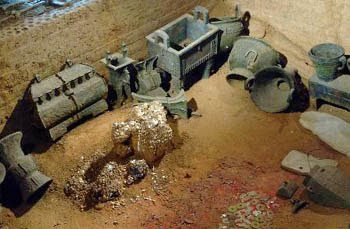The later Shang capitals at Anyang and Shangqiu are better
known archaeologically. Anyang is thought to have been the sixth and final
capital of the Shang dynasty. By around 1200 BC, the city comprised a
metropolitan area of some 15km2, consisting of multiple occupation clusters
spread along a 6km stretch of the Yellow River. Anyang was not merely a
conglomeration of villages - large-scale residential foundations thought to be
palaces have been found at Xiaotun, and tombs of a scale indicative of royal
burial are present at Xibeigang, where a large number of inscribed oracle bones
attest to a qualitative change in social organization. Three clusters of hangtu
foundations have been identified at Xiaotun, a total of 53 individual
foundations of which the largest is 2800m2. Storage pits containing the remains
of grain, bronze weapons, oracle bones, and fine pottery have been identified
around the palatial foundations. Craft workshops and commoner residences are
also present, indicating that bronze casting and jade, shell, bone, and stone
working were conducted in the area around the palaces. The Xiaotun sector is
thought to be the administrative-ceremonial core of Anyang, administering a web
of surrounding settlement clusters.
One of the outlying sites that constitute the Anyang urban
web is Xibeigang, where 13 monumental tombs have been excavated. All of these
consist of a primary pit accessed by ramps that share the same orientation and
have evidence of extensive sacrificial burials (including humans, dogs, horses,
and other animals) associated with the burials of prominent individuals.
Although these have been extensively looted, the FuHao tomb excavated at Xiaotun
offers us a sense of the wealth of grave goods placed with prominent
individuals. This tomb belonged to a wife of the ruler Wu Ting and contained 16
human sacrificial victims, six dogs, 7000 cowrie shells, and more than 1600
other items (bronzes, jades, oracle bones, stone objects, ivory carvings,
pottery, and shell objects).
More research is needed to clarify patterns of urban
development in China, but it is clear that cities with populations exceeding
100 000 had developed by Eastern Zhou times (771-221 BC), when urban
settlements exhibit a more nucleated character and a more consistent layout. By
this time, the urban form included a walled inner city (wangcheng) that
contained a palace, an outer city (guo), and a surrounding hinterland of
suburbs (jiao) and farming hamlets (yie). Zhou cities were commercial centers
with thriving craft industries and well-developed administrative hierarchies.
It is undeniable that these cities developed out of
millennia-long traditions of settlement organization. Longshan social
development saw the appearance of walled compounds of a few hectares, possibly
areas of elite residence and craft production that were surrounded by commoner
settlement. By the mid-second millennium BC, China's largest sites covered
several square kilometers and had sizeable precincts (sometimes walled) in
which monumental architecture, palatial residences, ritual spaces, and storage
facilities were located. Craft production appears to have become more
specialized and was carried out on a larger scale in workshops outside of the
inner city. Farmers lived in rural communities outside of the cities. It
appears that the inner parts of these early cities were planned to a degree not
seen at the urban periphery, which grew more organically in a number of linked
settlement clusters.

No comments:
Post a Comment